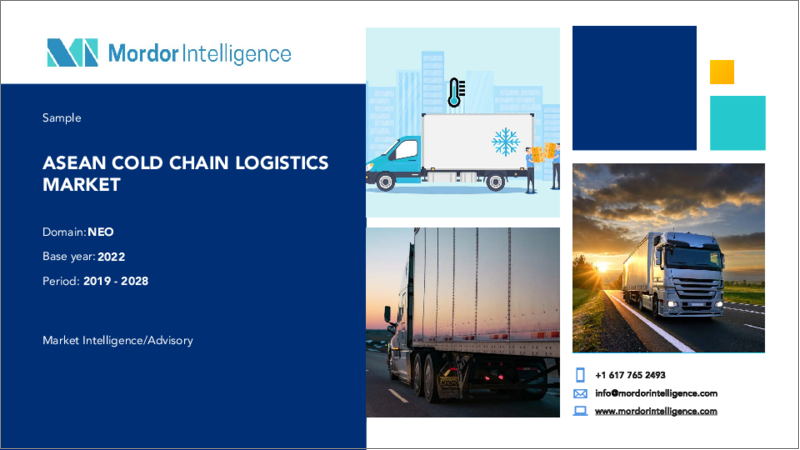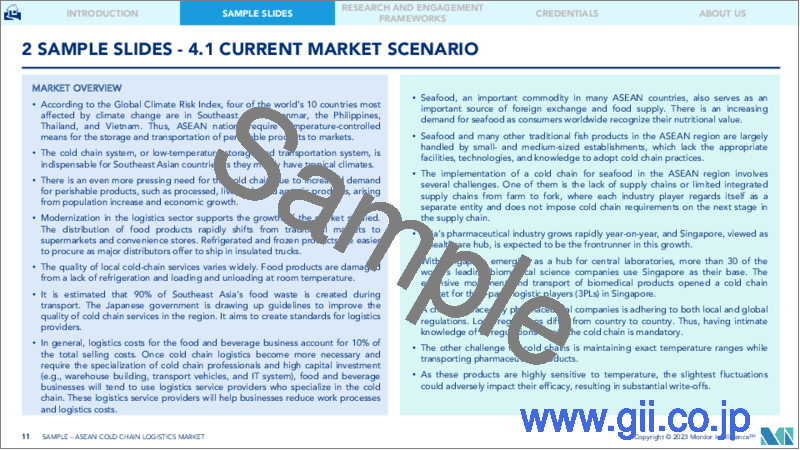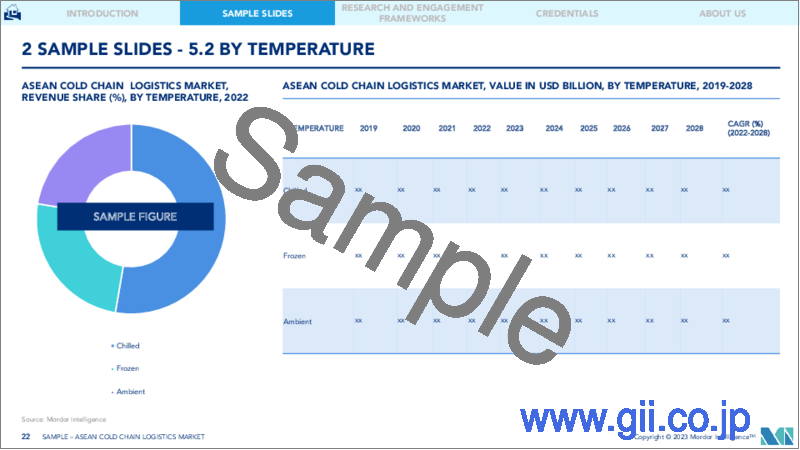|
|
市場調査レポート
商品コード
1199639
ASEANのコールドチェーンロジスティクス市場- 成長、動向、予測(2023年-2028年)ASEAN Cold Chain Logistics Market - Growth, Trends, and Forecasts (2023 - 2028) |
||||||
|
● お客様のご希望に応じて、既存データの加工や未掲載情報(例:国別セグメント)の追加などの対応が可能です。 詳細はお問い合わせください。 |
|||||||
| ASEANのコールドチェーンロジスティクス市場- 成長、動向、予測(2023年-2028年) |
|
出版日: 2023年01月23日
発行: Mordor Intelligence
ページ情報: 英文 150 Pages
納期: 2~3営業日
|
- 全表示
- 概要
- 目次
ASEANのコールドチェーンロジスティクス市場は、予測期間中に12%以上のCAGRで推移すると予想されています。
主なハイライト
- 経済に影響を及ぼすCOVID-19の大流行により、オペレーション、サプライチェーン、規制、労働力の要件が大きく変化し、コールドチェーンロジスティクス部門が大きく揺らいでいます。ロジスティクス分野の近代化は、冷蔵ロジスティクス市場の成長を支えています。
- 都市人口の増加と消費者の意識の変化が、冷蔵保管・輸送の需要を押し上げています。東南アジアでは、冷蔵・冷凍製品の市場が急速に拡大しています。ASEAN・東アジア経済研究所(ERIA)によると、タイでは公共・民間合わせて94万トンの冷蔵倉庫のキャパシティがあります。ベトナムでは、民間企業で50万パレット以上の容量があります。インドネシアとミャンマーの能力値はそれぞれ37万200メートルトン、8万8148メートルトンだが、これは大手企業の能力値でしかないです。
- 食品の流通は、伝統的な市場からスーパーマーケットやコンビニエンスストアへと急速にシフトしています。冷蔵・冷凍食品は、大手流通業者が保冷車による配送を行っているため、調達しやすくなっています。地域のコールドチェーンサービスの質には大きな差があります。冷蔵不足による食品の傷みが発生しています。東南アジアの食品廃棄物の90%は輸送中に生じたものと推定されます。
- ASEAN諸国における所得水準の上昇とライフスタイルの変化が、これらの地域における食肉消費と生産の成長の主要因であり、インドネシアとベトナムが主に成長を牽引しています。ASEANの医薬品業界の市場規模は、予測期間中に1,483億米ドルに達する見込みです。医薬品の多くは温度に敏感で、特にCOVIDワクチンの輸送など、ラストワンマイルまでの輸送が必要とされます。
ASEANのコールドチェーンロジスティクス市場の動向
ハラール食品産業は市場に牽引力を与えている
- 近年、世界ブランドは、購買力の向上と消費者の支出優先順位の変化に対応するため、イスラム経済に注目し始めています。ASEAN地域には約2億6千万人のイスラム教徒が住んでおり、その多くはインドネシア、マレーシア、タイ、フィリピン、シンガポール、ミャンマー、ブルネイに居住しています。過去10年間にこの地域で開催されたハラールライフスタイルのイベントやキャンペーンの数は、イスラムの旅行、食品、ファッション、化粧品への関心を刺激しています。
- 韓国の大手食品会社SPCグループは、全世界で2兆ドル規模といわれるハラール食品産業の一角を担うべく、マレーシアに進出する意向です。SPCグループは、シンガポールに隣接するマレーシアのジョホール州に、400億ウォン(約3000万米ドル)を投じてハラル認証工場を建設する計画を発表しました。韓国メディアによると、この施設は港湾があるため、東南アジア全域や中東に商品を送るルートがあるとのこと。
- ハラール食品は肉類が多いため、各国政府のハラール認証を受けたコールドチェーン倉庫に保管する必要があっています。最近では、ハラール産業の発展を目的としたいくつかの政策が政府によって示されており、その中にはハラール産業のための経済特区(KEK)の設立も含まれています。
- また、シャリア経済金融国家委員会(KNEKS)とユニリーバインドネシアなどの企業との連携は、同国のハラル産業を後押しするものと期待されています。マレーシア政府も、ハラル市場の世界マーケットリーダーとなるべく、さまざまな前進を遂げています。ハラル産業のマスタープランやハラルパークは、政府による最近の進歩です。こうしたハラルへの取り組みが、ASEAN諸国のコールドチェーン物流を牽引しています。
食肉消費量の増加がASEAN諸国のコールドチェーンロジスティクスを推進
- 東南アジアでは人口の増加、所得の増加、都市化、小売業の発展により、食肉の消費量が増加し、飼料の輸入も増加しています。この地域内の主要な新興市場は、インドネシア、マレーシア、フィリピン、タイ、ベトナムの5カ国です。近年、肉の消費量も増加しているが、魚介類が最大の肉消費・生産源であり、飼料需要の一部を担っています。東南アジアの国々はそれぞれ肉の嗜好が異なり、それは消費量と生産量に反映されています。
- マレーシアは鶏肉部門に大きな生産設備を持ち、これらの東南アジア諸国の中で最高の生産額を誇っています。鶏肉消費量は一人当たり年間50kgで、需給ともに自給自足です。世界最大の鶏肉輸出国であり、消費国でもあるタイは、2020年の統計によると、住民一人当たり年間8kgの鶏肉を消費しています。2021年末までに、国際機関の報告書では、牛肉の生産量が増加することが予測されています。今年の牛肉の生産量は5800万トンまで上昇し、2021年から1%増加すると思われます。しかし、肉の消費量は増加すると思われます。
- ベトナムとフィリピンは、この地域で次に大きな豚肉消費国であり、一人当たりの年間消費量はそれぞれ25 kgと14.9 kgです。これらの肉製品はすべて生鮮食品であり、小売店や一部の冷凍パック食品として配送する必要があるため、ASEAN地域ではコールドチェーンロジスティクスが大きく急増しています。
ASEANのコールドチェーンロジスティクス市場の競合他社分析
ASEANのコールドチェーンロジスティクス市場は、世界プレーヤーとローカルプレーヤーが混在する断片的な構造になっています。現地の中小規模のプレーヤーは、現在でも小規模なフリートや保管スペースで市場にサービスを提供しています。シンガポールのように、DHLや日本通運のような世界プレーヤーが強い存在感を示している国もあります。さらに、世界プレイヤーは、この地域での足跡を増やすために、市場への投資や地元企業の買収を進めています。例えば、郵船ロジスティクスの子会社であるタスコは、マレーシアの大手コールドチェーンサービスプロバイダー2社を買収しました。また、現地企業もコールドチェーンインフラへの投資を行い、規格に適合するよう世界プレーヤーと競争しています。さらに、日本の物流企業は、製造業や流通業において、国ごとに陸上輸送の拠点をASEANに設置するなど、ASEAN地域での活動を強化し、サプライチェーンの構築を推し進めています。また、コールドチェーンの構築にも取り組み、青果物、花卉、化粧品、消費財関連の物流に積極的に投資しています。
その他の特典
- エクセル形式の市場予測(ME)シート
- アナリストによる3ヶ月間のサポート
目次
第1章 イントロダクション
- 調査の前提条件と市場の定義
- 市場の範囲
第2章 調査手法
- 分析手法
- 調査フェーズ
第3章 エグゼクティブサマリー
第4章 マーケットインサイト
- 現在の市場シナリオ
- 市場力学
- 促進要因
- 抑制要因
- 機会
- 冷蔵倉庫の技術動向と自動化
- 政府の規制と取り組み
- ASEANのコールドチェーン産業における日本の役割に関するレビューと解説
- 業界のバリューチェーンに関する洞察
- 業界の魅力- ポーターのファイブフォース分析
- コールドチェーン業界における排出基準および規制の影響
- 冷蔵倉庫で使用される冷媒と包装材料に関する洞察
- インドネシアとマレーシアのハラール規格と認証に関する洞察
- 環境/温度管理された保管庫に関する洞察
- COVID-19が市場に与える影響
第5章 市場セグメンテーション
- サービス別
- 保管
- 輸送
- 付加価値サービス(ブラストフリージング、ラベリング、在庫管理など)
- 温度別
- チルド
- フローズン
- アプリケーション別
- 野菜・果物
- 乳製品(牛乳、バター、チーズ、アイスクリームなど)
- 魚・肉・鶏肉
- 加工食品
- 医薬品(バイオファーマを含む)
- ベーカリー・菓子類
- その他の用途
- 地域別情報
- シンガポール
- タイ
- ベトナム
- インドネシア
- マレーシア
- フィリピン
- その他のASEAN
第6章 競争環境
- 市場集中度の概要
- 企業プロファイル
- Nippon Express
- United Parcel Service of America
- Deutsche Post DHL
- Yamato Transport Co. Ltd
- DSV Agility Logistics
- NYK (Yusen Logitics & TASCO)
- Tiong Nam Logistics
- Sinchai Cold Storage
- Jentec Storage Inc.
- JWD Logistics
- KOSPA
- PT. Pluit Cold Storage
- PT. Wahana Cold Storage
- Havi Logistics
- Royal Cargo
- Thai Max Co. Ltd
- MGM Bosco
第7章 市場の将来性
第8章 主要ベンダーとサプライヤー
- ストレージ機器メーカー
- キャリアメーカー
- テクノロジープロバイダー
第9章 付録
- 冷蔵倉庫の年間統計
- 冷凍食品の輸出入貿易データ
- 主要国における食品輸送と貯蔵に関する規制の枠組みについての洞察
- 東南アジアの食品・飲料セクターに関する洞察
The ASEAN Cold Chain Logistics Market is anticipated to register a CAGR of more than 12% over the forecast period.
Key Highlights
- The COVID-19 pandemic challenging the economy has upended the cold chain logistics sector with massive changes in operations, supply chains, regulations, and workforce requirements. Modernization in the logistics sector has supported the growth of the refrigerated logistics market.
- The growing urban population and changing consumer perception have boosted refrigerated storage and transport demand. The market for refrigerated/frozen products is rapidly growing in Southeast Asia. According to the Economic Research Institute for ASEAN and East Asia (ERIA), Thailand has a total capacity of 940,000 metric tons for both public and private cold storage facilities. In Vietnam, the private sector has a capacity of more than 500,000 pallets. Capacity figures for Indonesia and Myanmar are 370,200 metric tons and 88,148 metric tons, respectively, but these only represent the capacities of major companies.
- The distribution of food products is rapidly shifting from traditional markets toward supermarkets and convenience stores. Refrigerated and frozen products are easier to procure, as major distributors offer shipping via insulated trucks. The quality of local cold-chain services varies widely. Food products have been damaged due to the lack of refrigeration. It is estimated that 90% of Southeast Asia's food waste is created during transport.
- Rising income levels in ASEAN countries and lifestyle changes are key factors for the growth of meat consumption and production in these regions, Indonesia and Vietnam are mainly driving the growth. The ASEAN pharmaceutical industry has a market cap of USD 148.3 billion over the projected years. Most of the drugs are temperature sensitive and need to be transported to the last mile, especially the transportation of the COVID vaccine.
ASEAN Cold Chain Logistics Market Trends
Halal Food Industry is offering traction to the market
- In recent years, global brands have begun to focus on the Muslim economy to capitalize on rising purchasing power and shifting consumer spending priorities. Around 260 million Muslims live in the ASEAN region, most of whom live in Indonesia, Malaysia, Thailand, the Philippines, Singapore, Myanmar, and Brunei. The number of halal lifestyle events and campaigns held across the region in the last decade stimulates interest in Islamic travel, foods, fashion, and cosmetics.
- SPC Group, a major South Korean food company, intends to grow into Malaysia to capture a portion of the USD 2 trillion worldwide halal food industry. In Johor, a Malaysian state bordering Singapore, SPC Group announced plans to invest 40 billion won (about USD 30 million) in the construction of a halal-certified factory. According to South Korean media, the facility will have a route to send goods throughout Southeast Asia and into the Middle East thanks to the location's ports.
- Since most halal food is meat products, they needed to be stored in cold chain warehouses that are Halal certified by the respective Governments. In recent times, several policies aimed at developing the halal industry have been demonstrated by the government, including the establishment of a Special Economic Zone (KEK) for the industry.
- In addition, the collaboration between the National Committee for Sharia Economics and Finance (KNEKS) and companies such as Unilever Indonesia is expected to boost the country's halal industry. The Malaysian government is also making many advancements to become a global market leader in the halal market. The halal industry's master plan and halal park are the recent advancements made by the government. All these halal initiatives are driving the cold chain Logistics in ASEAN countries.
Increase in Meat Consumption Propelling Cold Chain Logistics in ASEAN Countries
- Southeast Asia's expanding population and increasing incomes, urbanization, and retail sectors are contributing to rising meat consumption and growing imports of feedstuffs. The five key emerging markets within the region are Indonesia, Malaysia, the Philippines, Thailand, and Vietnam. In recent years, meat consumption also increased, although fish and seafood are the largest meat sources consumed and produced-and are partially responsible for feedstuffs demand. Every Southeast Asian country has different meat preferences, as reflected by their levels of consumption and production.
- Malaysia has a sizable production apparatus in the poultry sector, which has the best production values among these Southeast Asian nations. With a 50 kg/per capita yearly consumption of poultry meat, this nation is self-sufficient in both supply and demand. The world's greatest producer of poultry exports, as well as a significant consumer, is Thailand, which, according to statistics from 2020, consumes 8 kg of poultry annually per inhabitant. By the end of 2021, reports from international agencies predicted that beef output will increase. The production of beef would rise to 58 million metric tons this year, an increase of 1% from 2021. However, meat consumption would rise.
- Vietnam and the Philippines are the next two biggest pork consumers in the region, with annual per capita consumption of 25 kg and 14.9 kg, respectively. As all these meat products are perishable and have to be delivered in retail outlets and some as frozen packed foods, there is a huge surge in Cold chain Logistics in the ASEAN region.
ASEAN Cold Chain Logistics Market Competitor Analysis
The ASEAN cold chain logistics market's landscape is fragmented in nature with a mix of global and local players. Small- and medium-sized local players still serve the market with small fleets and storage spaces. Some of the countries, like Singapore, have a strong presence of global players, like DHL and Nippon Express. Additionally, global players are investing in the market and acquiring local companies to increase their footprint in the region. For instance, Tasco, a subsidiary of Yusen Logistics, acquired two major cold chain service providers in Malaysia. Local enterprises are also investing in cold chain infrastructure to compete with global players to meet the standards. Furthermore, Japanese logistics companies strengthen their activities in the ASEAN region by setting up bases of land transportation in ASEAN countries for each country within the manufacturing and distribution industries, thereby pushing the construction of a supply chain. The companies are also involved in developing the cold chain and actively investing in logistics related to fruits and vegetables, flowers, cosmetics, and consumer goods.
Additional Benefits:
- The market estimate (ME) sheet in Excel format
- 3 months of analyst support
TABLE OF CONTENTS
1 INTRODUCTION
- 1.1 Study Assumptions and Market Definition
- 1.2 Scope of the Market
2 RESEARCH METHODOLOGY
- 2.1 Analysis Methodology
- 2.2 Research Phases
3 EXECUTIVE SUMMARY
4 MARKET INSIGHTS
- 4.1 Current Market Scenario
- 4.2 MARKET DYNAMICS
- 4.2.1 Drivers
- 4.2.2 Restraints
- 4.2.3 Opportunities
- 4.3 Technological Trends and Automation in Cold Storage Facilities
- 4.4 Government Regulations and Initiatives
- 4.5 Review and Commentary on Role of Japan in the ASEAN Cold Chain Industry
- 4.6 Insights into Industry Value Chain
- 4.7 Industry Attractiveness - Porter's Five Forces Analysis
- 4.8 Impact of Emission Standards and Regulations in the Cold Chain Industry
- 4.9 Insights into Refrigerants and Packaging Materials Used in Refrigerated Warehouses
- 4.10 Insights into Halal Standards and Certifications in Indonesia and Malaysia
- 4.11 Insights into Ambient/Temperature-controlled Storage
- 4.12 Impact of COVID-19 on the Market
5 MARKET SEGMENTATION
- 5.1 By Service
- 5.1.1 Storage
- 5.1.2 Transportation
- 5.1.3 Value-added Services (Blast Freezing, Labeling, Inventory Management, etc.)
- 5.2 By Temperature
- 5.2.1 Chilled
- 5.2.2 Frozen
- 5.3 By Application
- 5.3.1 Fruits and Vegetables
- 5.3.2 Dairy Products (Milk, Butter, Cheese, Ice Cream, etc.)
- 5.3.3 Fish, Meat, and Poultry
- 5.3.4 Processed Food
- 5.3.5 Pharmaceutical (Include Biopharma)
- 5.3.6 Bakery and Confectionery
- 5.3.7 Other Applications
- 5.4 By Geography
- 5.4.1 Singapore
- 5.4.2 Thailand
- 5.4.3 Vietnam
- 5.4.4 Indonesia
- 5.4.5 Malaysia
- 5.4.6 Philippines
- 5.4.7 Rest of ASEAN
6 COMPETITVE LANDSCAPE
- 6.1 Market Concentration Overview
- 6.2 Company Profiles
- 6.2.1 Nippon Express
- 6.2.2 United Parcel Service of America
- 6.2.3 Deutsche Post DHL
- 6.2.4 Yamato Transport Co. Ltd
- 6.2.5 DSV Agility Logistics
- 6.2.6 NYK (Yusen Logitics & TASCO)
- 6.2.7 Tiong Nam Logistics
- 6.2.8 Sinchai Cold Storage
- 6.2.9 Jentec Storage Inc.
- 6.2.10 JWD Logistics
- 6.2.11 KOSPA
- 6.2.12 PT. Pluit Cold Storage
- 6.2.13 PT. Wahana Cold Storage
- 6.2.14 Havi Logistics
- 6.2.15 Royal Cargo
- 6.2.16 Thai Max Co. Ltd
- 6.2.17 MGM Bosco*
7 FUTURE OF THE MARKET
8 KEY VENDORS AND SUPPLIERS
- 8.1 STORAGE EQUIPMENT MANUFACTURERS
- 8.2 CARRIER MANUFACTURERS
- 8.3 TECHNOLOGY PROVIDERS
9 APPENDIX
- 9.1 Annual Statistics on Refrigerated Storage Facilities
- 9.2 Import and Export Trade Data of Frozen Food Products
- 9.3 Insights into Regulatory Framework on Food Transportation and Storage in Key Countries
- 9.4 Insights into the Food and Beverage Sector in Southeast Asia




